In 2013, counterfeit goods accounted for a staggering $461 billion worldwide. Nike holds the title as the most counterfeited brand globally, while Ray-Ban, Rolex, Supreme, and Louis Vuitton are among the most frequently copied. Though some replicas closely resemble the originals, subtle differences set them apart—ones you should be aware of.
At Bright Side, we’re here to help you spot fake products by highlighting key distinctions between authentic items and counterfeits from some of the world’s most popular brands.
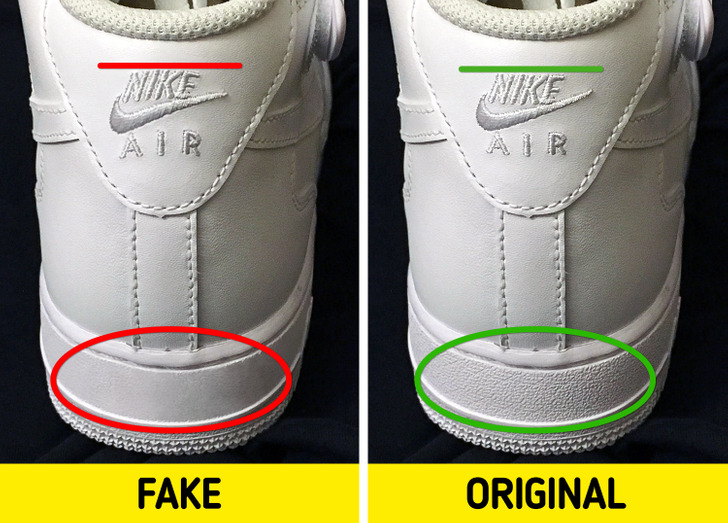
- Nike Air sneakers have a texture that counterfeit manufacturers cannot imitate. This is because their materials are different, and so are their devices. Thus, in authentic Nike shoes, you will notice a hardness in the leather that will be missing in the counterfeit ones.
- You will also need to examine the symmetry of the sneakers. If something looks asymmetrical, then it may be a counterfeit product.
2. Ray-Bans
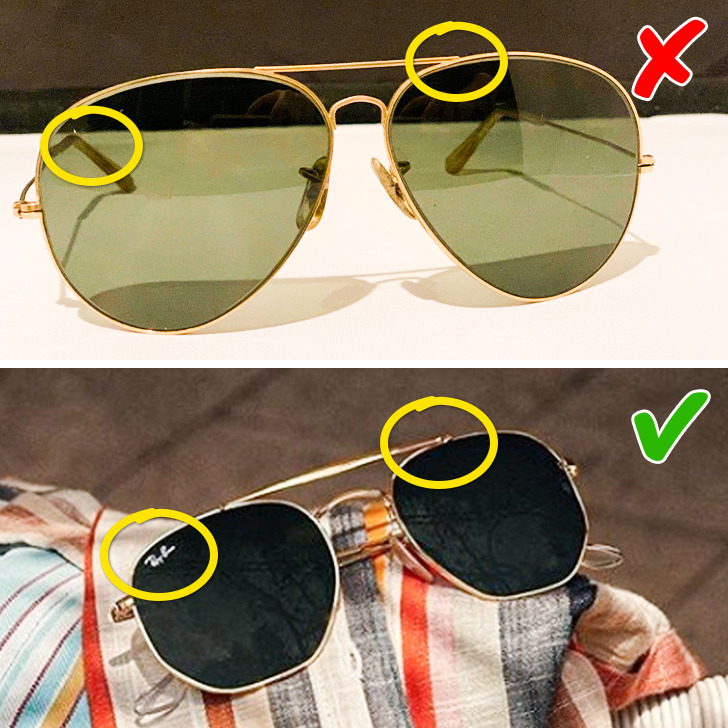
Authentic Ray-Ban lenses with plastic frames are crafted from a single piece, ensuring seamless construction. For metal frames, the central part should have a clean, refined appearance, with small details but no protruding points.
Most Ray-Ban lenses are made of real glass, though some models feature plastic lenses. To verify your pair, check the manufacturer’s official website for details.
A key authenticity marker is the Ray-Ban logo engraved in the upper right corner of the right lens—it cannot be erased. Additionally, the outer side of the temples should include the manufacturer’s inscription. You’ll also find the serial number on the left temple and the country of manufacture on the right.
3. Fila shoes
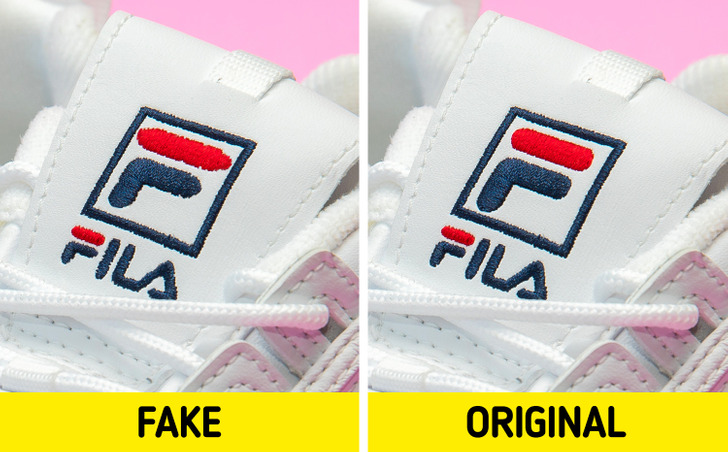
When examining the letter “F” on your Fila shoes, you might notice slight irregularities in the stitching—this is completely normal for authentic Fila footwear. However, what shouldn’t happen is the top two edges of the “F” appearing overly sharp or nearly touching the surrounding square, a common flaw in counterfeit versions.
Next, pay close attention to the details on the toe cap, particularly the perforations at the front. The spacing between these holes should be even—if they appear inconsistent, there’s a good chance your sneakers are fake.
Additionally, check the heel logo. On genuine Fila sneakers, this logo matches the one found on the tongue, whereas fakes may feature a completely different design.
4. Burberry scarf
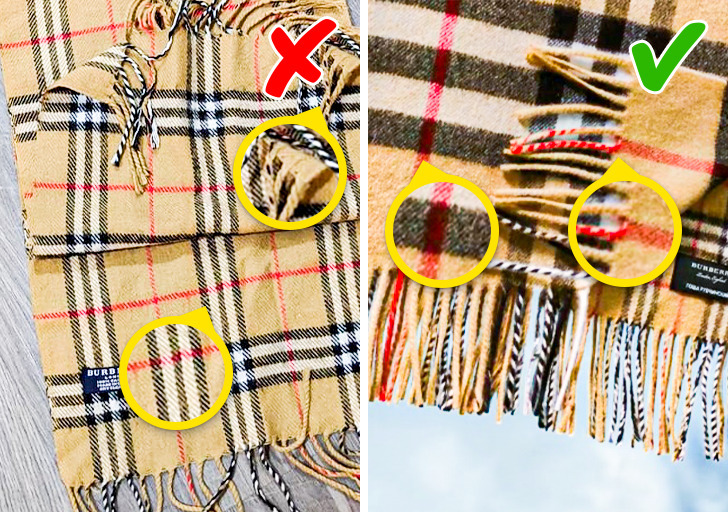
- The authentic scarf always has well-defined lines and a dense texture.
- The fringe yarns in a scarf should be well rolled and spaced apart, they do not fall apart when touched.
- The brand name on the label attached to the article must be written in capital letters. Also, the label must contain information about the country of manufacture and the composition of the scarf.
5. Gucci handbags
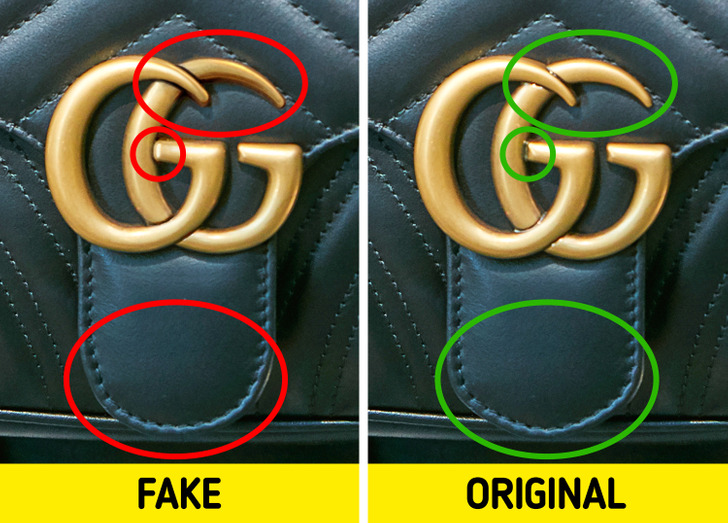
Start by examining the two “G’s” on the front of your bag. The serifs should be long and sleek, not thick or bulky. Additionally, the rounded part of each “G” should form a perfect oval rather than appearing pointed. If the logo looks blurry or poorly defined, it’s likely a fake.
Next, take a close look at the stitching. A genuine Gucci bag will have precise, even stitching throughout. If you notice uneven stitches or thread that differs in color from the bag itself, chances are it’s a counterfeit.
6. Supreme sweatshirt
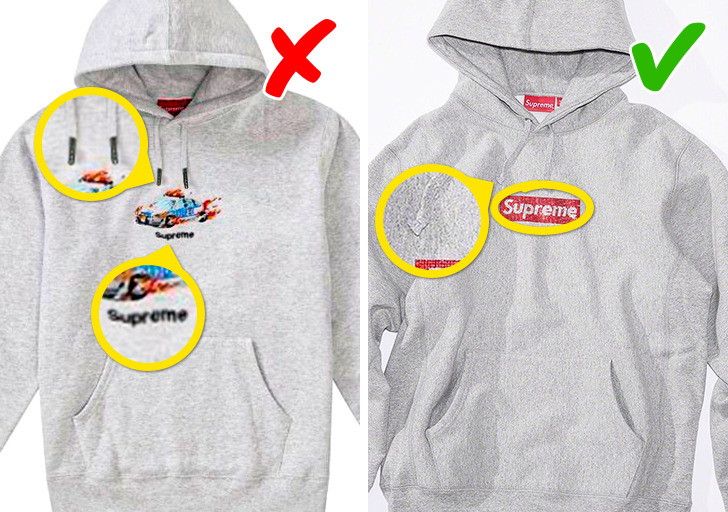
On the collar of both hooded and non-hooded sweatshirts from this brand, you’ll find two dark red labels. The larger one displays the brand name with an encircled “R,” while the smaller label indicates the country of manufacture: Canada. Additionally, the inner care label should include a warning not to iron the garment—something often overlooked by counterfeit manufacturers.
For sweatshirts with embroidered logos, the letters on the red portion should be evenly spaced and properly aligned. Turning an authentic sweatshirt inside out reveals a fine mesh of white threads on the back of the logo.
Supreme sweatshirts exclusively feature flat laces on the hoods, neatly tied at the ends. If the laces are round, burned at the tips, or have inconsistent terminations, it’s a strong indication of a fake.
7. Adidas Yeezy tennis shoes
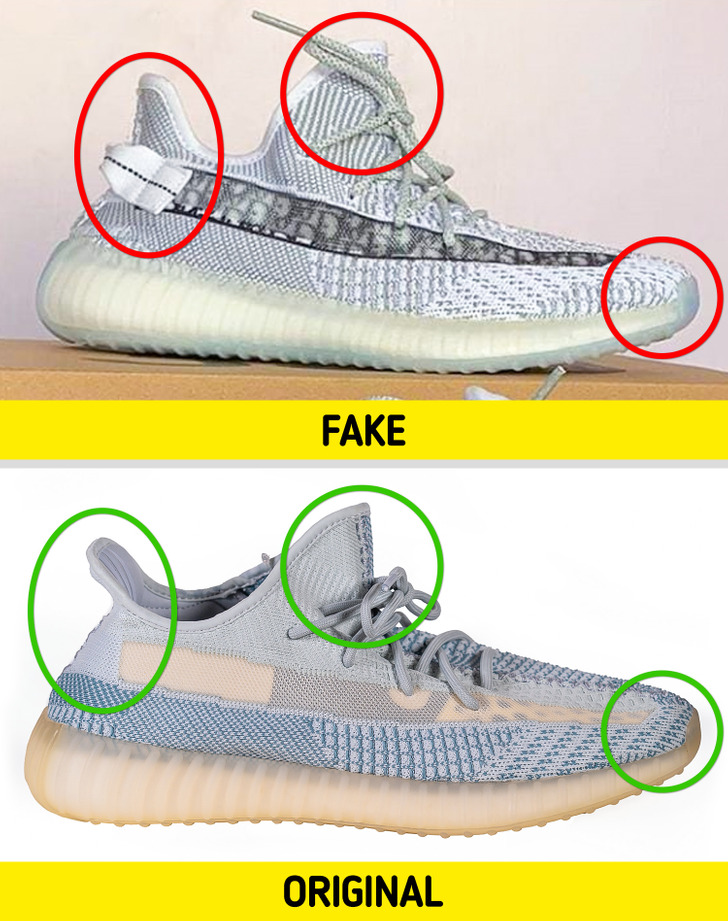
Start by examining the wave pattern on the original Yeezy—it should be sideways with irregular wave prints.
Next, take a look at the tongue of the sneakers. Authentic Yeezy tongues have a more curved shape, whereas fake ones tend to appear much straighter.
Then, check the inside of the shoes and compare the Adidas logo on each shoe. In some counterfeit versions, the logo sizes may differ.
Lastly, inspect the stitching on the inside. If it looks uneven or poorly done, it could be a sign of a fake pair.
8. New Balance sneakers
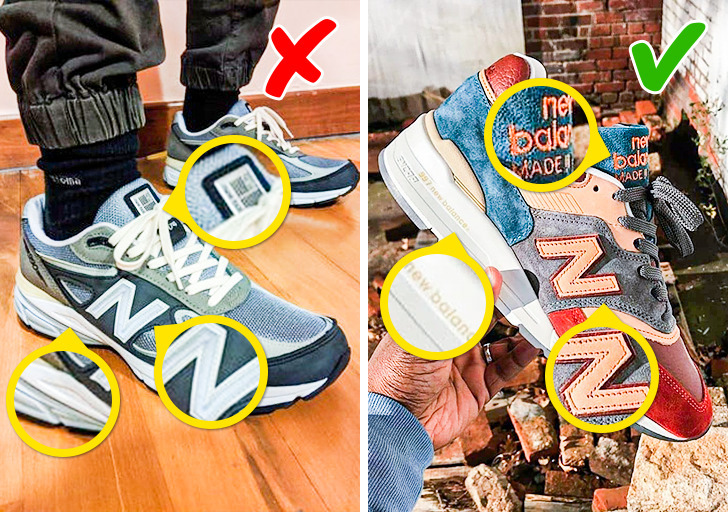
New Balance sneakers have brand symbols on the back, tongue, the side of the sneaker, and the side of the sole, on the sole itself, and the insoles. The logo in the shape of the letter N on the side of the sneaker is made in the form of a patch.
The original slippers have a soft sole, made of foam material, easily compresses and quickly returns to their original state. The sole protector is made of rubber. The insoles of authentic New Balance shoes have a perforation, logo, size, and information about the model.
9. Toms espadrilles
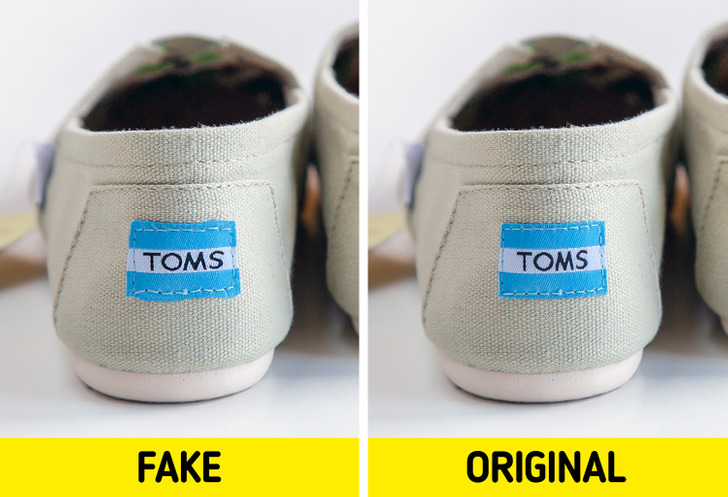
Start by inspecting the insoles of your espadrilles. If they can be removed, chances are they’re fake, as authentic pairs have insoles sewn securely to the bottom.
Next, examine the back of the espadrilles and check the logo. The letters on a genuine pair are perfectly balanced and square, while fake ones often have pointed, uneven letters—especially the “O.” Additionally, the stitching around the label tends to be thicker on counterfeit versions.
Lastly, look at the sides of the shoes for any visible glue. A high-quality brand ensures a seamless finish, whereas knockoffs often have noticeable glue marks.
10. Michael Kors Handbag
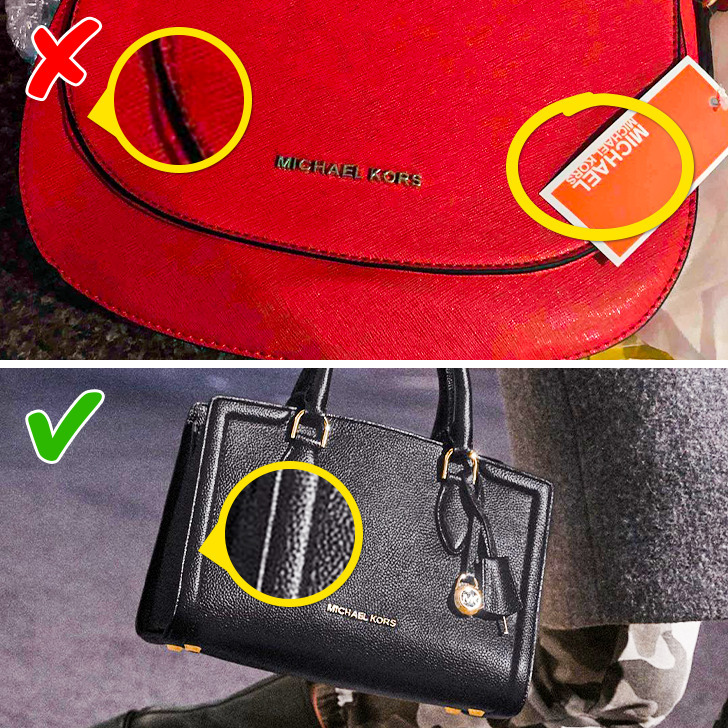
For its bags, the brand uses only cream-colored labels containing the primary information about the product: serial number, shade, material, parameters, the price in USD, and a unique bar code.
All parts of the original bags are engraved with the brand name. It is applied to magnetic clips, handle rings, clasps, carabiners, and fasteners.
The brand’s authentic bags are made from a dense material that does not deform even during shipping when the item is packed.
11. Guess handbags
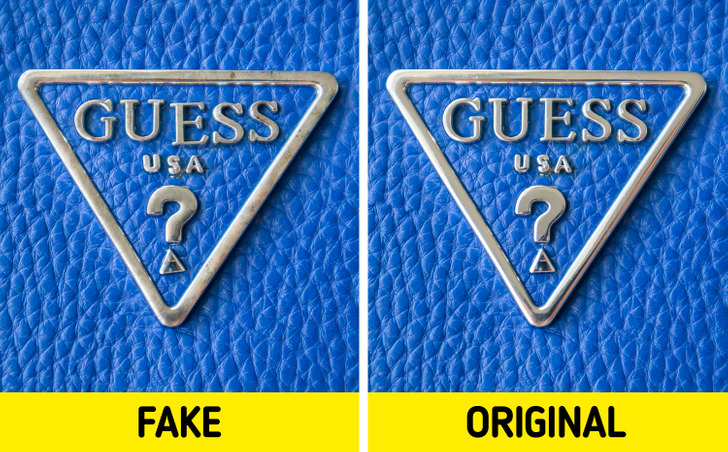
First, examine the material of the Guess handbag. Authentic bags are made of leather, while counterfeits use cheaper synthetic materials. To test this, press the fabric with your finger—if the wrinkles remain and don’t disappear, it’s not genuine leather.
Next, check the lining inside the bag. Original Guess bags have a soft, well-made lining, whereas fake ones may lack a lining entirely or have an extremely thin, paper-like layer.
Lastly, inspect the metal details. Authentic Guess bags feature sturdy, shiny hardware with a smooth surface, while counterfeit versions often use dull, low-quality metal that may have visible imperfections or marks.
12. Guess watches
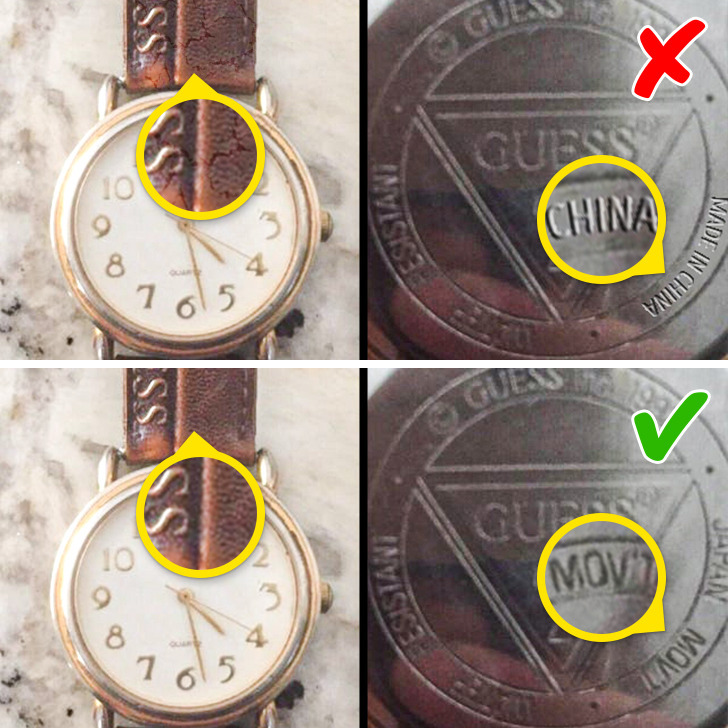
Straps for Guess watches are made of metal, silicone, or natural leather. A lousy product smell, uneven color, cracks, scratches, and wear on the strap indicate that we are dealing with an imitation.
The back should contain basic information about the watch: a logo with the brand name, the material of the watch body (as a rule, it is steel), and data about the watch mechanism with the engraving Japan Movt (as Guess uses only high-quality Japanese mechanisms).
13. Hermès handbags
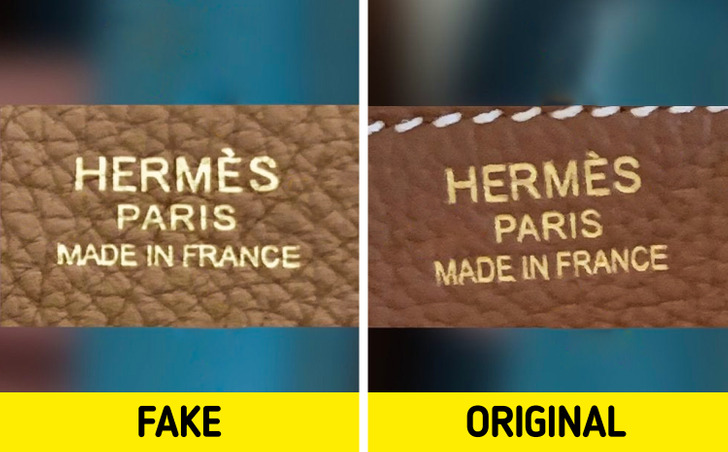
First, examine the inside printing on the leather, paying close attention to the lettering. On an authentic Hermès bag, the French accent on the letter “É” is refined and smooth, whereas counterfeit versions often have a rough, uneven appearance. Additionally, the letters “F” and “R” in the word “France” should be distinct—if they appear too close or fused together, it’s likely a fake.
Next, inspect the leather strap and its stitching. A genuine Hermès bag features precise, elegant, and flawless stitching. In contrast, counterfeit versions often have uneven stitching, with some areas appearing thicker or less refined than on an authentic bag.
14. Lacoste polo
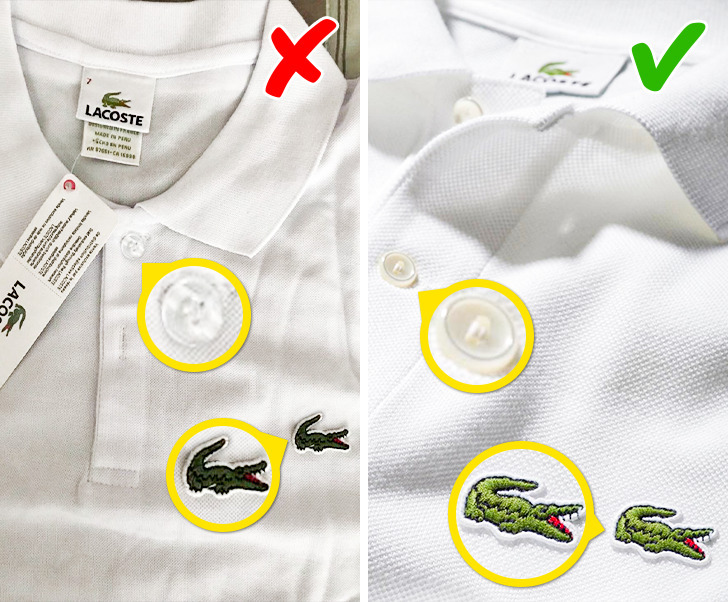
- The Lacoste crocodile is always made with clearly defined details. Its eyes, teeth, legs, and red mouth are clearly visible. The crocodile’s body is bright green, and the tail runs parallel to the back.
- At the base of the polo neck, there is a white label with the logo and a red number indicating the size. In men’s models, it is one number, while in women’s models, it is two.
- An imitation Lacoste polo shirt can be spotted because of a small detail: its buttons. Original Lacoste garments have mother-of-pearl buttons with two holes. They have no inscriptions. Replica manufacturers often forget that, so they use buttons with four holes.
- In the men’s models, at the bottom, on the sides of the polo shirt, there are small openings approximately 1/2 inches deep. In women’s versions, the manufacturer does not make any cuts.
15. Balenciaga shoes
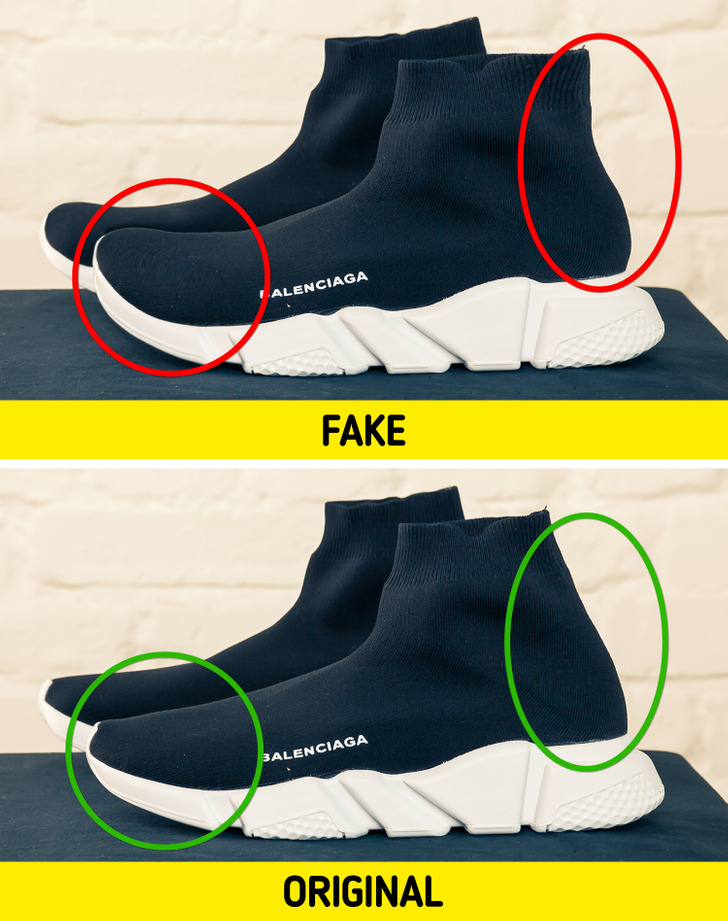
The Lacoste crocodile logo is always crafted with precise details—its eyes, teeth, legs, and red mouth are clearly defined. The crocodile’s body is a vibrant green, and its tail runs parallel to its back.
At the base of the polo neck, you’ll find a white label featuring the logo and a red number indicating the size. For men’s models, the number is a single digit, whereas women’s models display two digits.
One of the easiest ways to spot a fake Lacoste polo is by checking the buttons. Authentic Lacoste garments have mother-of-pearl buttons with two holes and no inscriptions. Counterfeit versions often use buttons with four holes, a detail commonly overlooked by replica manufacturers.
Additionally, men’s Lacoste polo shirts have small side slits at the bottom, approximately ½ inch deep, while the women’s versions do not have these openings.
16. Pandora bracelet
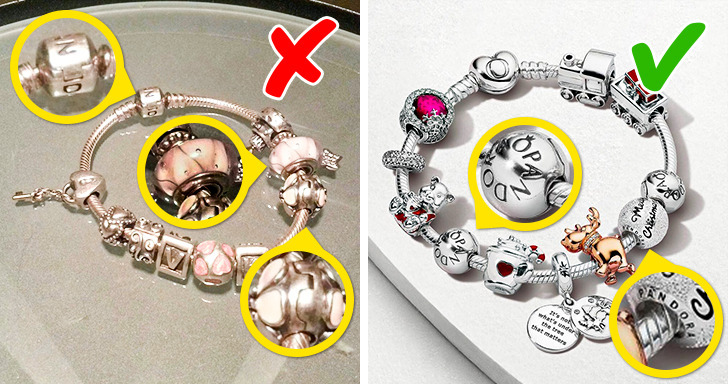
The authentic silver Pandora bracelet has a slightly muted tone—not overly bright or shiny. This unique color comes from a blackening technique used during manufacturing.
A brand-new original bracelet maintains its perfect shape with well-defined edges along its striated silver cord and minimal bending.
The clasp of a genuine Pandora bracelet is roughly the same size as the charms. On its front, you’ll find the engraved Pandora logo, with a crown positioned above the letter “o.”
Inside the clasp, there is a distinctive fastening mechanism: a clover-shaped screw with four heads that ensures a secure fit. Additionally, the clasp must display a quality seal indicating the metal’s purity, along with the initials “ALE” as a mark of origin.
Pandora charms also feature an engraving of the brand name and the metal type. Since 2011, “S” has been used for silver and “G” for gold. Murano glass charms are of the highest quality, free from cracks, broken sections, or air bubbles.
.
17. Levi’s
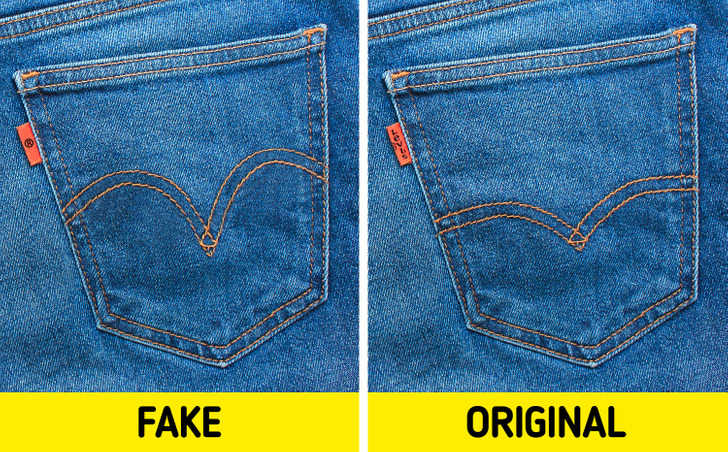
18. Timberland boots
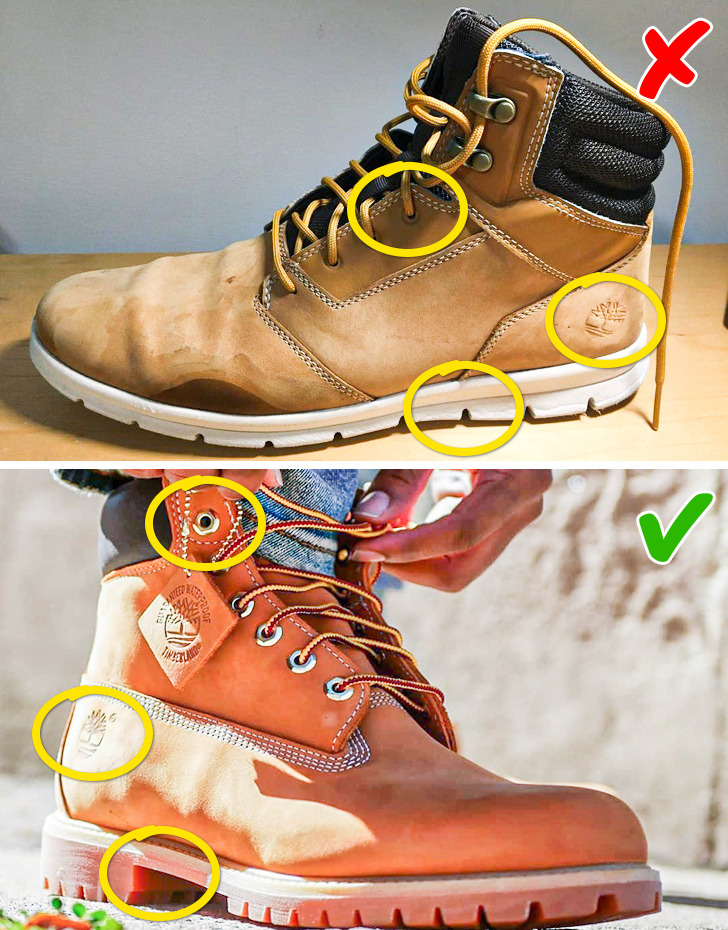
The sole has a caramel color, but if you look at it closely, it seems slightly transparent. The company logo and the brand name are printed on them, and the sole is uniform. The heel part does not protrude, but forms a continuous line.
The logo is located on the outside, at the bottom of the boot above the heel. Its print is uniform and well-defined, located strictly vertically.
The eyelets on the boots are perfect hexagons, which are ideally rounded on the outside. In men’s models, there are 7, in women’s models, 6.
All seams on the boots are made with white thread. If there are several seams close, they are clearly parallel to each other.
19. Nike t-shirts
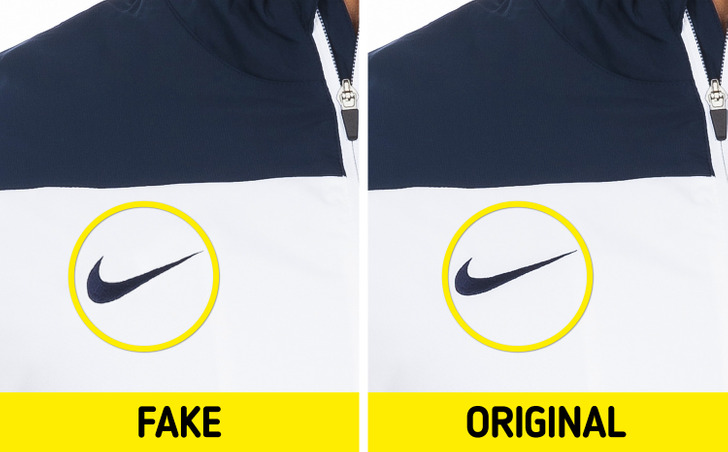
The first detail to inspect is the Nike logo. Counterfeit versions often have slight discrepancies in proportions, with variations in angle and inclination that differ from the original.
Next, check the inner label for any spelling mistakes. Authentic Nike products will never have misspelled words, whereas fake items may contain errors.
Additionally, examine the labels near the bottom of the shirt. Genuine Nike shirts typically have two or more labels sewn in, while counterfeit versions usually have only one.
Have you ever accidentally purchased a fake product? How did you realize it wasn’t authentic? Could you spot the difference on your own, or did you need an expert’s help?